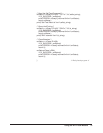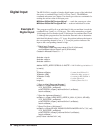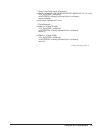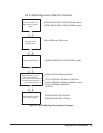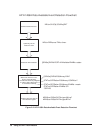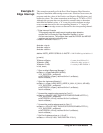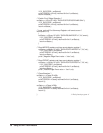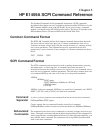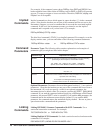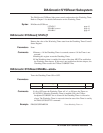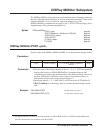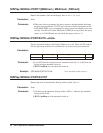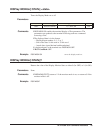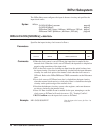
HP E1459A SCPI Command Reference 39
Chapter 3
HP E1459A SCPI Command Reference
The Standard Commands for Programmable Instruments (SCPI) commands
described in this chapter are only available in the downloadable SCPI driver for the
HP Command Modules such as the HP E1406. If you are not using a command
module, you should use the HP VXIplug&play driver. This driver is available on the
HP Instrument Drivers CD and available on the World Wide Web.
Common Command Format
The IEEE 488.2 standard defines the Common commands that perform functions
like reset, self-test, status byte query, etc. Common commands are four or five
characters in length, always begin with the asterisk character (*), and may include
one or more parameters. The command keyword is separated from the first
parameter by a space character. Some examples of common commands are shown
below:
*RST *ESR 32 *STB?
SCPI Command Format
The SCPI commands perform functions such as making measurements, querying
instrument states, or retrieving data. A command subsystem structure is a
hierarchical structure that usually consists of a top level (or root) command, one or
more low-level commands, and their parameters. The following example shows the
root command DISPlay and some of its lower-level subsystem commands:
:DISPlay
:MONitor
:PORT <port>
:PORT? [MINimum | MAXimum | DEFault]
[:STATe] <state>
[:STATe]?
:DISPlay is the root command, :MONitor is a second level commands, and :PORT,
PORT?, [:STATe], and [:STATe]? are third level commands.
Command
Separator
A colon (:) always separates one command from the next lower level command:
DISPlay:MONitor:PORT <
port
>.
Colons separate the root command from the second level command
(
DISPlay:MONitor) and the second level from the third level (MONitor:CHANnel).
Abbreviated
Commands
The command syntax shows most commands as a mixture of upper and lower case
letters. The upper case letters indicate the abbreviated spelling for the command. For
shorter program lines, send the abbreviated form. For better program readability, you
may send the entire command. The instrument will accept either the abbreviated
form or the entire command.



